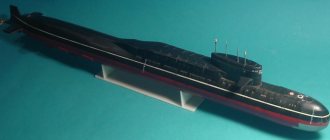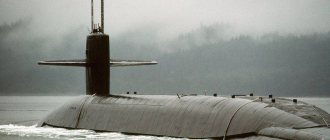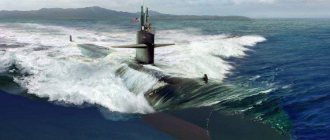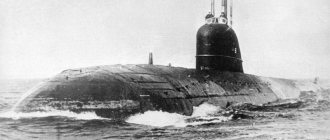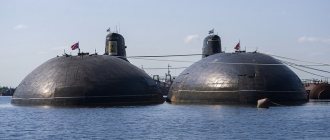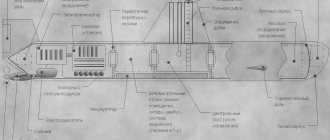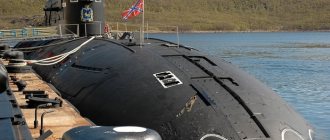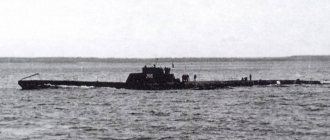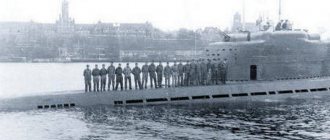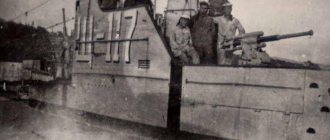Nuclear submarines with ballistic missiles of the K-19 type. Project 658 (Hotel-I class)
The experience that was accumulated during the design and construction of the first Soviet nuclear torpedo submarines and diesel-electric missile carriers, Projects B-611 and 629, made it possible to begin in the mid-1950s. to the creation of the first domestic nuclear submarine armed with ballistic missiles. The ship was designed to launch nuclear missile strikes on ports, naval bases, administrative and industrial centers located not only on the coast, but also inland. In order to shorten the implementation period of the program, as well as reduce the technical risk when creating a fundamentally new class of combat ships, it was decided to develop the first Soviet nuclear submarine with ballistic missiles based on design solutions that were implemented on the Project 627 nuclear torpedo submarine. In fact, a missile carrier that received project number 658, was a Leninsky Komsomol boat with an additional missile compartment embedded in the hull.
K-19
The party and government resolution on the creation of the Project 658 nuclear missile submarine was issued on August 26, 1956. The design of the ship was entrusted to TsKB-18 (today - the Central Design Bureau of Marine Equipment "Rubin"). The development of design documentation began in September 1956. The work was supervised by chief designer S.N. Kovalev. From the very beginning of work on the project, Deputy the chief designer was I.D. Spassky, and the main observer from the navy was captain of the second rank K.I. Martynenko. The technical design was completed in the first quarter of 1957 (the preliminary design of the submarine was not developed due to the extremely tight deadlines dictated by the realities of the “arms race”).
The ship, according to the original plans, was supposed to be equipped with weapons, the development of which was already coming to an end - the D-2 missile system and R-13 liquid-propellant missiles, which had a surface launch (tests of this complex, which was originally developed to arm diesel-electric submarines of Project 629, were started in December 1958). However, in 1958 they decided to begin developing a project that involved re-equipping the submarine with more promising missiles that had an underwater launch. It was assumed that the new complex would be installed on nuclear-powered ships during the process of modernization and overhaul.
The start of work on the first Soviet SSBN coincided with similar work in the United States, where the Polaris program began to be implemented in 1956. But if in the USSR the Project 658 submarine was considered as a kind of synthesis of existing technologies, then the American fleet was creating a fundamentally new weapon system, which was based on an unparalleled small-sized solid-fuel ballistic missile with an underwater launch. The American missile had significantly greater capabilities compared to its Soviet counterpart. At the same time, the first carrier of the Polaris, the nuclear submarine with the George Washington ballistic missile, like the vessels of Project 658, was developed on the basis of an existing project, the Skipjack-class torpedo submarine. Moreover, during the construction of the first series of SSBNs for the US Navy, ready-made hull structures of nuclear submarines were used, as a result of which the lead submarine missile carrier was handed over to the fleet on December 30, 1959, a year earlier than the Soviet nuclear-powered submarine. The small dimensions of the Polaris and the compact and simple launching device made it possible to install sixteen missiles (eight silos in two rows) on the George Washington.
The limited width of the SSBN hull of Project 658, adopted from Project 627, as well as the solid dimensions of Soviet ballistic missiles, complex and bulky launch devices (due to the fact that they were developed according to the design standards for gun mounts for heavy surface vessels), allowed the installation of missile silos on a submarine only in one row. Three missiles were placed in the wheelhouse enclosure, which resulted in unusually large dimensions, very far from optimal (from the point of view of hydrodynamics).
Compared to the Project 627 torpedo submarine, several significant changes were made to the design of the nuclear missile submarine. For example, small stern horizontal rudders were used to control at high speed. The submarine received a more durable and quieter electro-hydraulic system for controlling the rudders. Provision was made for blowing the main ballast using low pressure air. An autonomous fire extinguishing system was installed in the reactor compartment. Due to the requirements to ensure high seaworthiness on the surface, during pre-launch preparation and launch of missiles, they abandoned the “torpedo-shaped” shape of the submarine’s bow and returned to traditional stem contours.
The first Soviet-made nuclear-powered missile ship, in comparison with a similar American vessel, had higher surface and underwater speeds, better combat survivability, increased immersion depth, being inferior to it in terms of stealth and information technology characteristics. Project 658 was a very significant loser in terms of the ship's tonnage to the weight of its missile armament. If on the American "George Washington" for every ton of "Polaris" A-1 there was a little more than 30 tons of displacement, then on a Soviet-made boat this value increased to almost 130 tons.
The SSBN of the 658th project, like other domestic nuclear submarines, was of the double-hull type. The submarine's robust hull was divided into ten compartments. The outer body was made according to a longitudinal system. Thus, significant metal savings and other technological advantages were ensured over the transverse mounting system previously used on Soviet submarines.
Already during serial construction, some submarines were equipped with a noise-absorbing coating on the outer skin. The coating was made of special rubber, and made it difficult to track the ship with enemy hydroacoustic systems operating in active mode (it should be noted that such coatings were introduced in the USSR Navy for the first time in the world). However, the first generation coatings were not very durable, and by the 1970s, almost all ships of the 658 project were sailing “scraped.”
The submarine had a main power plant with a capacity of 35 thousand liters. pp., including 2 water-cooled reactors VM-A with a power of 70 mW (placed sequentially in the middle part in the center plane of the vessel, one after another) with steam generators and 2 turbo-gear units 60-D. In addition, the SSBN had 2 electric “sneak” motors PG-116 (each with a power of 450 hp) and 2 diesel generators DG-400 with M-820 diesel engines. The submarine was equipped with a direct current electrical system (380 V, 400 Hz).
The ship was equipped with an all-latitude navigation complex "Sigma" with an astrocorrector. The sonar armament included the Arktika hydroacoustic station (Arktika-M), the first domestic hydroacoustic system with a reflex combined antenna, which ensured operation in distance measurement and noise direction finding modes. In noise direction finding mode, the station had a range of 1...18 km, echo direction finding - 8 km.
The torpedo armament of the nuclear submarine with ballistic missiles consisted of 4 bow 533-mm torpedo tubes (the ammunition load included 16 torpedoes 53-61, 53-65K and SET-65) and 2 400-mm stern small-sized torpedo tubes (6 torpedoes ). Torpedo tubes of 400 mm caliber, designed to fire anti-submarine torpedoes, served for self-defense and provided firing at a depth of up to 250 meters. 533 mm could be used at a depth of 100 m. The fire control system was Leningrad-658.
To break away from the enemy, the submarine could use MG-14 (hydroacoustic countermeasures devices), which were fired from torpedo tubes. They were replaced in 1967 by the MG-24, a self-propelled acoustic jamming device weighing 7 kilograms, used at a depth of 30-40 meters for 30 minutes. The MG-24 was fired through a special VIPS device. In the same year, the drifting combined small-sized device MG-34, used at depths of 30-200 meters, entered service with submarines. It is also shot through VIPS.
The submarines of the 658th project were equipped with the D-2 missile system having three R-13 ballistic missiles (ind. 4K50, designation in the west SS-N-4 “Sark”). The launch was carried out from a surface position. The R-13 was the world's first specialized ballistic missile designed to arm submarines. The single-stage rocket, whose launch weight was 13.7 tons, carried a detachable warhead equipped with a high-power thermonuclear charge. The launch range was 650 kilometers, the probable circular deviation was 4 kilometers, which ensured the destruction of only area targets (mainly naval bases and large cities located on the coast). To operate the rocket engine, TG-02 fuel and AK-27I oxidizer were used. Since the used pair of propellant components, which self-ignite when combined, was a source of increased fire hazard, it was decided to store the rocket in the silo, which was filled only with an oxidizer. The fuel was located in special containers (separate for each of the three missiles) outside the submarine’s durable hull and was supplied to the missile during pre-launch preparation. The Dolomite-1 system was used to control the firing of ballistic missiles.
On the first domestic nuclear-powered missile ships, the habitability conditions, in general, differed slightly from the conditions on large post-war diesel-electric submarines. However, each crew member of the Project 658 SSBN had his own sleeping place (this is still not the case for American submariners serving on third-generation Los Angeles-class nuclear submarines). The rich contents of the provision chambers of domestic nuclear submarines in the 1960-70s. largely compensated for everyday inconveniences.
In 1960, during tests of the K-19, the lead nuclear submarine with ballistic missiles, at 80 percent of the reactor power, an underwater speed of 23.8 knots was developed, which, in terms of 100% power, provided a speed of 25.9 knots. In October 1960, the first successful rocket launches were carried out.
The characteristics of the missile system significantly limited the combat capabilities of the Project 658 boats. From the surface of the submarine to the launch of the 3rd missile, it took about 12 minutes, which made the ship, located in close proximity to the coast of a potential enemy (due to the short range of ballistic missiles), an excellent target for American anti-submarine aircraft.
The appearance of the first nuclear-powered missile carriers in the USSR Navy for US naval intelligence, of course, did not go unnoticed. Soon the new ships were given the NATO designation “Hotel class”.
Modifications
In 1958, the development of the new D-4 RK and R-21 missiles, which could be launched from a submarine under water and had an increased flight range, began. The new missile was demonstrated to Khrushchev in February 1962, and the following year it was put into service. This made it possible to begin re-equipping the Project 658 SSBN with the D-4 complex. The modernized boats were given project number 658-M.
To accommodate the R-21, the same launchers were used as for the R-13 missiles, since they initially had a larger internal diameter. To launch the R-21, the shafts were filled with water. The launch weight of the single-stage ballistic missile was 19.65 tons. It could deliver a 0.8-megaton warhead to a distance of 1,420 kilometers, with a CEP of 1.3 kilometers. Since the D-4 complex was installed on the boat, it was necessary to ensure that the vessel was kept at a given depth when launching a rocket from an underwater position (the total impact of the force impulses that arose during the rocket launch was the reason that the boat rose from the current depth to almost 16 meters, which made it difficult to launch the next missile in the salvo). Therefore, for the SSBN of Project 658-M, a so-called retention system was developed, which ensures automatic maintenance of a given depth.
During the modernization, other improvements were made to the submarine's design. For example, they changed the ship's KSPPO (pre-launch preparation and maintenance system). For pre-launch filling of the annular gap (the space between the rocket body and the wall of the shaft) with water, special ones were installed. tanks equipped with a pumping system.
In 1965-1970, modernization and re-equipment along Project 658-M was carried out during the overhaul of seven submarines (except K-145). At the same time, in the West these submarines were given the designation “Hotel-II class”.
The A-658 project was also being worked on. It provided for the re-equipment of Project 658 submarines with the D-5 missile system. The program was closed at the preliminary design stage.
The K-145 SSBN was modernized in 1969-1970 according to the 701st project for the final stage of flight testing of ballistic missiles for R-29 submarines. An additional 15-meter section of the hull was inserted into the central part of the submarine, where 6 shafts of the D-9 complex were placed. The cutting fence was also lengthened.
In 1977, when the US-Soviet SALT-1 treaty on the limitation of nuclear weapons came into force, it was decided to remove strategic weapons from the Project 658-M nuclear submarine. On six submarines, the missile compartments were cut out along with the silos, and the boats were converted according to Project 658-T and reclassified as torpedo (in the west, “Modified Hotel-II class”).
The nuclear submarine K-19 was converted into a prototype Project 658-S ship in 1976-79. it was used to test various new devices and systems, including pre-production and experimental ones. She was the first of the Project 658-M submarines from which the missile system was removed. After this, the submarine was transferred to the class of special-purpose submarines. The submarine conversion project was developed at TsKB-18. In 1979, they decided to use this boat to test submarine radio communication systems. The first sample that passed the state. tests, there was a towed release antenna device “Zalom”.
In the 1980s, the K-55 and K-178 nuclear submarines were again converted from torpedo submarines on Project 658-U (in the west they were given the designation “Hotel-II SSQN class”). They were transformed into communications ships. The torpedo armament was retained, but the ammunition load was reduced due to the placement of additional equipment.
Construction program
Construction of the first Soviet nuclear-powered missile ships began at plant No. 402 in Severodvinsk. In the serial construction of ships for the first time (in relation to nuclear submarines) in our country, the block construction method and other technological innovations began to be used. The first submarine of the 658th project - K-19 - was laid down on 10/17/1958, it was launched on 04/08/1959, and entered service on 11/12/1960. 06.07. 1961 The Northern Fleet was replenished with a nuclear submarine with ballistic missiles K-33, 08/12/1962 - K-55, 12/28/1962 - K-40, 05/15/1963 - K-16, 12/19/1963 - K-145, 02/12/1964 - K -149 and 06/30/1964 – K-176. Thus, over the course of six years, we successfully implemented a large-scale, unique for the Soviet defense complex, program for the construction of a series of 8 nuclear-powered missile carriers, which carried a total of 24 ballistic missiles with high-power thermonuclear warheads.
Status for 2007
The first two submarines of the 658th project, which joined the Northern Fleet in 1960-1961, were sent to the Zapadnaya Litsa base. There they, together with Project 627-A nuclear torpedo submarines, formed a brigade. On the basis of this brigade, in January 1962, the 1st submarine flotilla was deployed, consisting of 2 divisions - the Third (Project 627-A) and the Thirty-First (Project 658). In 1964, the division of nuclear missile carriers was transferred to Gadzhievo (Yagelnaya base, Sayda Bay) to the Twelfth Squadron. Subsequently, the squadron was transformed into the 3rd nuclear submarine flotilla.
The K-55 and K-178 boats were transferred to the Pacific Fleet in 1963 and 1968, where they served in the forty-fifth division of nuclear submarines based in Kamchatka (by 1970 the submarines were modernized according to Project 658-M).
K-19 - the first Soviet nuclear-powered missile ship - began its service at the end of 1960. 07/04/1961, during the Arctic Circle exercises, when the submarine cruiser (commander captain of the second rank N.V. Zateev) was heading to a given area of the North Atlantic, where he needed to launch a rocket, surfacing from under the ice of the Arctic, the left side reactor failed - the auxiliary and main circulation pumps jammed. Within just two hours, the crew was able to install an emergency system for emergency cooling of the reactor, thus eliminating the threat of its explosion. But during the struggle for the life of the nuclear submarine, 14 people received heavy doses of radiation and died. Approaching diesel-electric submarines and surface vessels managed to evacuate the crew members and tow the submarine to Zapadnaya Litsa. During the renovation, which took place from 1962 to 1964, both nuclear reactors were replaced on the ship. Old reactors along with nuclear fuel were flooded in Abrosimov Bay. Today such actions look blasphemous, but in the 1960s, at the height of the American-Soviet nuclear confrontation, both opposing sides did not attach much importance to such things and proceeded mainly from technical considerations. expediency.
The tragedy that occurred on the K-19 became a good lesson for developers of nuclear power plants: standard emergency water spill systems were installed on all designed and operating reactors similar to those installed on the K-19 submarine.
After the 1961 accident, the K-19 SSBN received the nickname “Hiroshima” among sailors and earned the reputation of an “unlucky” ship. It should be noted that K-19 very actively lived up to its reputation. On November 15, 1969, K-19 collided in the Barents Sea with the American nuclear submarine SSN-615 “Gato” (Thrasher type), which was trying to secretly monitor the nuclear-powered submarine of the USSR Navy. Both ships were damaged. A fire broke out on board the Hiroshima northeast of Newfoundland on February 24, 1972, resulting in the death of 28 crew members (compartments 5, 8 and 9 burned out). It was decided to turn the next repair of the “unlucky” submarine into an experiment to determine the mobilization capabilities of the ship repair industry: the Severodvinsk ship repair facility was able to complete the work in less than five months. The repaired K-19 submarine was taken over by the former crew, who had recently survived the disaster. To move to Gadzhievo, it was “diluted” with sailors from other ships of the same type.
The return of the K-19 submarine to Gadzhievo was again marked by an emergency: while entering Saida Bay, a strong fire broke out on board the ship again - excess reserves of paint and fuels and lubricants, taken from the shipyard and hidden in the wheelhouse fence, ignited from the diesel engine. The crew extinguished the fire, there were no casualties. The sailors on the Gadzhiev piers, observing the smoking submarine, surrounded by tugs and fire ships, looked at each other knowingly: “Hiroshima” has returned...” K-19 continued to encounter troubles.
The service of other Project 658 submarines was more successful. K-115 in 1963 made the transition to the Pacific Fleet from the Northern Fleet, passing 1.6 thousand miles under the ice in six days. In 1968, the submarine K-55 made an under-ice crossing to the Pacific Fleet. A special feature of this passage was the presence of standard nuclear weapons on board the boat.
The creation of the first nuclear-powered missile submarines and the introduction of Project 629 diesel-electric missile submarines into the fleet made it possible in a short period of time to lay the foundations for the underwater component of the USSR’s strategic nuclear triad. In addition, a certain counterbalance to American nuclear submarines with ballistic missiles was created. Another “positive” factor was that the potential enemy was forced to begin implementing a complex, expensive program to improve its own anti-submarine forces.
Despite outdated equipment, high noise, relatively poor habitability conditions, as well as some other shortcomings, submarines of Project 658-M in the 1970s. remain combat-ready combat units of the fleet, solving the tasks assigned to them. These ships, patrolling in close proximity to the American coast (sometimes the crew could observe the coast of New England through a periscope), provided extremely short flight time for the missiles deployed on them. This made it difficult for a potential enemy to organize countermeasures against a missile strike (but on the other hand, it made the return of nuclear-powered ships to their native shores after completing the assigned task a very problematic matter).
The service of five nuclear submarines with Project 658-M ballistic missiles (later Project 658-T) as part of the Northern Fleet continued until 1988-1991. SSBNs K-16, -33, -40 and -149 were decommissioned in 1988-1990. They were in storage in Olenya Bay and Gremikha. The lead submarine of the series, K-19, was the last to lower the naval flag, in 1991. Nuclear-powered ships until the end of the 1990s. were in the Polyarny sludge (in the water area of SRZ-10).
The main tactical and technical characteristics of nuclear submarines with ballistic missiles of the K-19 type, pr. 658: Surface displacement - 4030 tons; Underwater displacement - 5300 tons; Maximum length – 114 m; Maximum width – 9.2 m; Draft along the vertical line – 7.5 m; Main power plant: - 2 pressurized water reactors of type VM-A, total power - 70 mW; — 2 GTZA-601; — 2 PPU OK-150; — 2 steam turbines with a total power of 35,000 hp. (25700 kW); — 2 GPM-21 turbogenerators, each with a power of 1400 kW; — 2 diesel generators DG 460 V, power each 460 kW; — 2 economical electric motors PG-116, each with a power of 450 hp; — 2 shafts; — 2 five-bladed propellers; Surface speed – 15 knots; Underwater speed - 26 knots; Working immersion depth – 240 m; Maximum diving depth – 300 m; Autonomy – 50 days; Crew - 104 people (including 31 officers) Strategic missile weapons: R-13 SLBM launchers (SS-N-4 "Sark") of the D-2 complex or SM-87-1 SLBM R-21 launchers (SS-N-5) of the D-4 complex (after modernization according to project 658-M) - 3 Torpedo armament: - 533-mm torpedo tubes - 4 (bow); - 533 mm 53-61, 53-65K, SET-65 - 16; - 400-mm torpedo tubes - 2 (aft); - 400 mm torpedoes - 6; Mine weapons: - can carry some torpedoes instead; Electronic weapons: - general detection radar - RLK-101 “Albatross” (Snoop Tray); Hydroacoustic system: — “Arktika-M”; — “Plutonium” mine detection; — MG-10 ShPS; — “Yacht” of underwater sound communications; Electronic warfare equipment: - “Roll-in” (Quad Loop D/F) RTR; — “Van” (Stop Light); GPD means: - GPD MG-14, MG-24, MG-34; Navigation complex: - “Sigma-658”; — radio sextant (Code Eye); — INS; — ARP-53 radio direction finder; Radio communication complex: - VHF and HF radio stations (“Tantal”, “Iskra-1”, “Graphite-1”, “Oniks-P”); — DV radio receiver “Depth”; State identification radar station - "Nichrome-M".
Project 627 submarines
The history of Soviet nuclear submarines began with Project 627. The boat began to be designed as a strategic carrier of nuclear weapons, in this case a hefty torpedo with a thermonuclear warhead. During the design work, it became clear that this weapon option had no prospects.
Apart from technical problems, it turned out that there are not many targets for such a torpedo, and even those are not of great strategic importance. The Project 627 boat received classic torpedo weapons.
The creation of this submarine was a real breakthrough for Soviet industry. After all, a nuclear submarine is the quintessential achievement of a wide variety of industries. According to project 627, one boat was built - K-3 “Leninsky Komsomol”.
The peculiarity of the creation of Project 627 is that the design was carried out without the participation of the military and without coordination with them. In the “serial” version of the boat, designated Project 627A, the comments and suggestions of the naval sailors were taken into account, but, naturally, drastic changes were impossible.
The main disadvantage of the first generation of Soviet torpedo boats was the high level of their own physical fields and the weakness of sonar equipment. Their combat properties made it possible to successfully fight enemy surface forces and the merchant fleet, but the tasks of anti-submarine warfare against new enemy boats were extremely difficult for them, and sometimes even inaccessible. 12 Project 627A nuclear submarines were built.
Project 659 submarines
The first nuclear-powered carrier of cruise missiles in the Soviet fleet were Project 659 boats armed with the P-5 missile system.
Their task was to destroy enemy targets with cruise missiles with a nuclear warhead, i.e. they served as strategic carriers of nuclear weapons. The P-5 missile system had insufficient firing range and low accuracy, and was quickly removed from fleet service. Five boats built according to this project were converted into torpedo boats according to Project 659T.
Subsequently, cruise missiles as strategic carriers of nuclear warheads were considered unpromising. This place was taken by ballistic missiles.
Project 645 submarines
The boat of Project 645 (1 unit built) used a nuclear power plant of a different type than that of Project 627A. Liquid metal (bismuth-lead alloy) was used as the coolant of the reactor primary circuit.
This design promised great advantages, but the technical difficulties turned out to be too many for the serial use of this type of reactor.
Other technical innovations were tested on this boat, some were considered unsuccessful, others were successfully used in other projects.
In the late 50s and early 60s, submarines received a new class of weapons - cruise missiles.
Project 675 submarines
And the main target of naval cruise missiles was American aircraft carrier formations. To combat them, Project 675 nuclear submarines and the P-6 missile system were created. The firing range of the P-6 significantly exceeded the boat’s target detection capabilities, so for external target designation, first the “Success” aviation reconnaissance system and then the “Legend” space reconnaissance system were created.
The result was an integral system of combating enemy surface ships, which included air and space reconnaissance and target designation equipment, weapons and their carriers. Project 675 boats were built in a very large series (29 units), were repeatedly modernized and successfully served in combat until the late 80s and early 90s.
